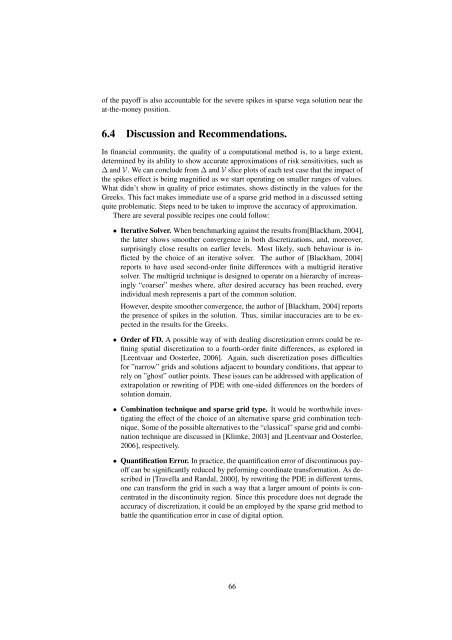sparse grid method in the libor market model. option valuation and the
sparse grid method in the libor market model. option valuation and the
sparse grid method in the libor market model. option valuation and the
You also want an ePaper? Increase the reach of your titles
YUMPU automatically turns print PDFs into web optimized ePapers that Google loves.
of <strong>the</strong> payoff is also accountable for <strong>the</strong> severe spikes <strong>in</strong> <strong>sparse</strong> vega solution near <strong>the</strong><br />
at-<strong>the</strong>-money position.<br />
6.4 Discussion <strong>and</strong> Recommendations.<br />
In f<strong>in</strong>ancial community, <strong>the</strong> quality of a computational <strong>method</strong> is, to a large extent,<br />
determ<strong>in</strong>ed by its ability to show accurate approximations of risk sensitivities, such as<br />
∆ <strong>and</strong> V. We can conclude from ∆ <strong>and</strong> V slice plots of each test case that <strong>the</strong> impact of<br />
<strong>the</strong> spikes effect is be<strong>in</strong>g magnified as we start operat<strong>in</strong>g on smaller ranges of values.<br />
What didn’t show <strong>in</strong> quality of price estimates, shows dist<strong>in</strong>ctly <strong>in</strong> <strong>the</strong> values for <strong>the</strong><br />
Greeks. This fact makes immediate use of a <strong>sparse</strong> <strong>grid</strong> <strong>method</strong> <strong>in</strong> a discussed sett<strong>in</strong>g<br />
quite problematic. Steps need to be taken to improve <strong>the</strong> accuracy of approximation.<br />
There are several possible recipes one could follow:<br />
• Iterative Solver. When benchmark<strong>in</strong>g aga<strong>in</strong>st <strong>the</strong> results from[Blackham, 2004],<br />
<strong>the</strong> latter shows smoo<strong>the</strong>r convergence <strong>in</strong> both discretizations, <strong>and</strong>, moreover,<br />
surpris<strong>in</strong>gly close results on earlier levels. Most likely, such behaviour is <strong>in</strong>flicted<br />
by <strong>the</strong> choice of an iterative solver. The author of [Blackham, 2004]<br />
reports to have used second-order f<strong>in</strong>ite differences with a multi<strong>grid</strong> iterative<br />
solver. The multi<strong>grid</strong> technique is designed to operate on a hierarchy of <strong>in</strong>creas<strong>in</strong>gly<br />
“coarser” meshes where, after desired accuracy has been reached, every<br />
<strong>in</strong>dividual mesh represents a part of <strong>the</strong> common solution.<br />
However, despite smoo<strong>the</strong>r convergence, <strong>the</strong> author of [Blackham, 2004] reports<br />
<strong>the</strong> presence of spikes <strong>in</strong> <strong>the</strong> solution. Thus, similar <strong>in</strong>accuracies are to be expected<br />
<strong>in</strong> <strong>the</strong> results for <strong>the</strong> Greeks.<br />
• Order of FD. A possible way of with deal<strong>in</strong>g discretization errors could be ref<strong>in</strong><strong>in</strong>g<br />
spatial discretization to a fourth-order f<strong>in</strong>ite differences, as explored <strong>in</strong><br />
[Leentvaar <strong>and</strong> Oosterlee, 2006]. Aga<strong>in</strong>, such discretization poses difficulties<br />
for ”narrow” <strong>grid</strong>s <strong>and</strong> solutions adjacent to boundary conditions, that appear to<br />
rely on ”ghost” outlier po<strong>in</strong>ts. These issues can be addressed with application of<br />
extrapolation or rewrit<strong>in</strong>g of PDE with one-sided differences on <strong>the</strong> borders of<br />
solution doma<strong>in</strong>.<br />
• Comb<strong>in</strong>ation technique <strong>and</strong> <strong>sparse</strong> <strong>grid</strong> type. It would be worthwhile <strong>in</strong>vestigat<strong>in</strong>g<br />
<strong>the</strong> effect of <strong>the</strong> choice of an alternative <strong>sparse</strong> <strong>grid</strong> comb<strong>in</strong>ation technique.<br />
Some of <strong>the</strong> possible alternatives to <strong>the</strong> “classical” <strong>sparse</strong> <strong>grid</strong> <strong>and</strong> comb<strong>in</strong>ation<br />
technique are discussed <strong>in</strong> [Klimke, 2003] <strong>and</strong> [Leentvaar <strong>and</strong> Oosterlee,<br />
2006], respectively.<br />
• Quantification Error. In practice, <strong>the</strong> quantification error of discont<strong>in</strong>uous payoff<br />
can be significantly reduced by peform<strong>in</strong>g coord<strong>in</strong>ate transformation. As described<br />
<strong>in</strong> [Travella <strong>and</strong> R<strong>and</strong>al, 2000], by rewrit<strong>in</strong>g <strong>the</strong> PDE <strong>in</strong> different terms,<br />
one can transform <strong>the</strong> <strong>grid</strong> <strong>in</strong> such a way that a larger amount of po<strong>in</strong>ts is concentrated<br />
<strong>in</strong> <strong>the</strong> discont<strong>in</strong>uity region. S<strong>in</strong>ce this procedure does not degrade <strong>the</strong><br />
accuracy of discretization, it could be an employed by <strong>the</strong> <strong>sparse</strong> <strong>grid</strong> <strong>method</strong> to<br />
battle <strong>the</strong> quantification error <strong>in</strong> case of digital <strong>option</strong>.<br />
66
















